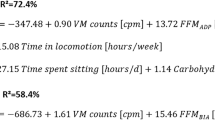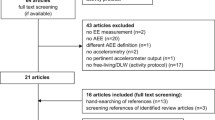Abstract
Numerous accelerometers and prediction methods are used to estimate energy expenditure (EE). Validation studies have been limited to small sample sizes in which participants complete a narrow range of activities and typically validate only one or two prediction models for one particular accelerometer. The purpose of this study was to evaluate the validity of nine published and two proprietary EE prediction equations for three different accelerometers. Two hundred and seventy-seven participants completed an average of six treadmill (TRD) (1.34, 1.56, 2.23 ms−1 each at 0 and 3% grade) and five self-paced activities of daily living (ADLs). EE estimates were compared with indirect calorimetry. Accelerometers were worn while EE was measured using a portable metabolic unit. To estimate EE, 4 ActiGraph prediction models were used, 5 Actical models, and 2 RT3 proprietary models. Across all activities, each equation underestimated EE (bias −0.1 to −1.4 METs and −0.5 to −1.3 kcal, respectively). For ADLs EE was underestimated by all prediction models (bias −0.2 to −2.0 and −0.2 to −2.8, respectively), while TRD activities were underestimated by seven equations, and overestimated by four equations (bias −0.8 to 0.2 METs and −0.4 to 0.5 kcal, respectively). Misclassification rates ranged from 21.7 (95% CI 20.4, 24.2%) to 34.3% (95% CI 32.3, 36.3%), with vigorous intensity activities being most often misclassified. Prediction equations did not yield accurate point estimates of EE across a broad range of activities nor were they accurate at classifying activities across a range of intensities (light <3 METs, moderate 3–5.99 METs, vigorous ≥6 METs). Current prediction techniques have many limitations when translating accelerometer counts to EE.




Similar content being viewed by others
References
American College of Sports Medicine (2009) ACSM’s resource manual for guidelines for exercise testing and prescription. Lippincott Williams & Wilkens, Philadelphia
Bassett DR Jr, Ainsworth BE, Swartz AM, Strath SJ, O’Brien WL, King GA (2000) Validity of four motion sensors in measuring moderate intensity physical activity. Med Sci Sports Exerc 32(Suppl):S471–S480
Byrne NM, Hills AP, Hunter GR, Weinsier RL, Schultz Y (2005) Metabolic equivalent: one size does not fit all. J Appl Physiol 99(3):1112–1119
Cavagna GA, Thys H, Zamboni A (1976) The sources of external work in level walking and running. J Physiol 262:639–657
Crouter SE, Bassett DR Jr (2008) A new two-regression model for the Actical accelerometer. Br J Sports Med 42:217–224
Crouter SE, Clowers KG, Bassett DR Jr (2006a) A novel method for using accelerometer data to predict energy expenditure. J Appl Physiol 100:1324–1331
Crouter SE, Churilla JR, Basset DR Jr (2006b) Estimating energy expenditure using accelerometers. Eur J Appl Physiol 98:601–612
de Weir JB (1949) New methods for calculating metabolic rate with special reference to protein metabolism. J Physiol 109:1–9
Freedson PS, Melanson E, Sirard J (1998) Calibration of the computer science and applications, Inc. accelerometer. Med Sci Sports Exerc 30:777–781
Healy GN, Wijndaele K, Dunstan DW, Shaw JE, Salmon J, Zimmet PZ, Owen N (2008) Objectively measured sedentary time, physical activity, and metabolic risk: the Australian Diabetes, Obesity and Lifestyle Study (AusDiab). Diabetes Care 31(2):369–371
Heil DP (2006) Predicting activity energy expenditure using the Actical activity monitor. Res Q Exerc Sport 77:64–80
HeltheTech (2003) MedGem User Manual. Golden, CO pp 3–7
Howe CA, Staudenmayer JW, Freedson PS (2009) Accelerometer prediction of energy expenditure: vector magnitude vs. vertical axis. Med Sci Sports Exerc 41(12):2199–2206
Klippel NJ, Heil DP (2003) Validation of energy expenditure prediction algorithms in adults using the Actical electronic activity monitor. Med Sci Sports Exerc 35:S284
Kozey SL, Lyden K, Staudenmeyer JW, Freedson PS (2010) Errors of MET estimates of physical activities using 3.5 ml.kg−1.min−1 as the baseline oxygen consumption. J Phys Activity Health
Matthews CE (2005) Calibration of accelerometer output for adults. Med Sci Sports Exerc 37(Suppl):S512–S522
Matthews CE, Chen KY, Freedson PS, Buchowski MS, Beech BM, Pate RR, Troiano RP (2008) Amount of time in sedentary behaviors in the United States, 2003–2004. Am J Epidemiol 167(7):875–881
Nieman DC, Trone GA, Austin MD (2003) A new handheld device for measuring resting metabolic rate and oxygen consumption. J Am Diet Assoc 103(5):588–592
Perret C, Mueller G (2006) Validation of a new portable ergospirometric device (Oxycon Mobile) during exercise. Int J Sports Med 27(5):363–367
Physical Activity Guidelines Advisory Committee (2008) Physical Activity Guidelines Advisory Committee Report, US Department of Health and Human Services. Washington, DC
R Development Core Team (2009) R: a language and environment for statistical computing. R Foundation for Statistical Computing, Vienna, Austria, ISBN 3-900051-07-0. http://www.R-project.org
Rosdahl H, Gullstrand L, Salier-Eriksson J, Johansson P, Schantz P (2009) Evaluation of the Oxycon Mobile metabolic system against the Douglas bag method. Eur J Appl Physiol
Rothney MP, Schaefer EV, Neumann MM, Choi L, Chen KY (2008) Validity of physical activity intensity predictions by ActiGraph, Actical and RT3. Obesity 16(8):1946–1952
Sallis JF, Saelens BE (2000) Assessment of physical activity by self-report: status, limitations and future directions. Res Q Exerc Sport 71(2):1–14
Stay Healthy Inc. RT3 User Manuel; Version 1.2. Available via http://www.stayhealthy.com
Staudenmayer J, Pober D, Crouter S, Bassett D, Freedson P (2009) An artificial neural network to estimate physical activity energy expenditure and identify physical activity type from an accelerometer. J Appl Physiol 107(4):1300–1307
Swartz AM, Strath SJ, Basset DR Jr, O’Brien WL, King GA, Ainsworth BE (2000) Estimation of energy expenditure using CSA accelerometers at hip and wrist sites. Med Sci Sports Exerc 32(Suppl):S450–S456
Troiano RP, Berrigan D, Dodd KW, Masse LC, Tilert T, McDowell M (2008) Physical activity in the United States measured by accelerometer. Med Sci Sports Exerc 40(1):180–188
Acknowledgments
The study was funded by NIH CA121005. The authors thank the graduate and undergraduate students who assisted with the data collection, as well as the subjects who volunteered their time as study participants.
Author information
Authors and Affiliations
Corresponding author
Additional information
Communicated by Klaas Westerterp.
Rights and permissions
About this article
Cite this article
Lyden, K., Kozey, S.L., Staudenmeyer, J.W. et al. A comprehensive evaluation of commonly used accelerometer energy expenditure and MET prediction equations. Eur J Appl Physiol 111, 187–201 (2011). https://doi.org/10.1007/s00421-010-1639-8
Accepted:
Published:
Issue Date:
DOI: https://doi.org/10.1007/s00421-010-1639-8




